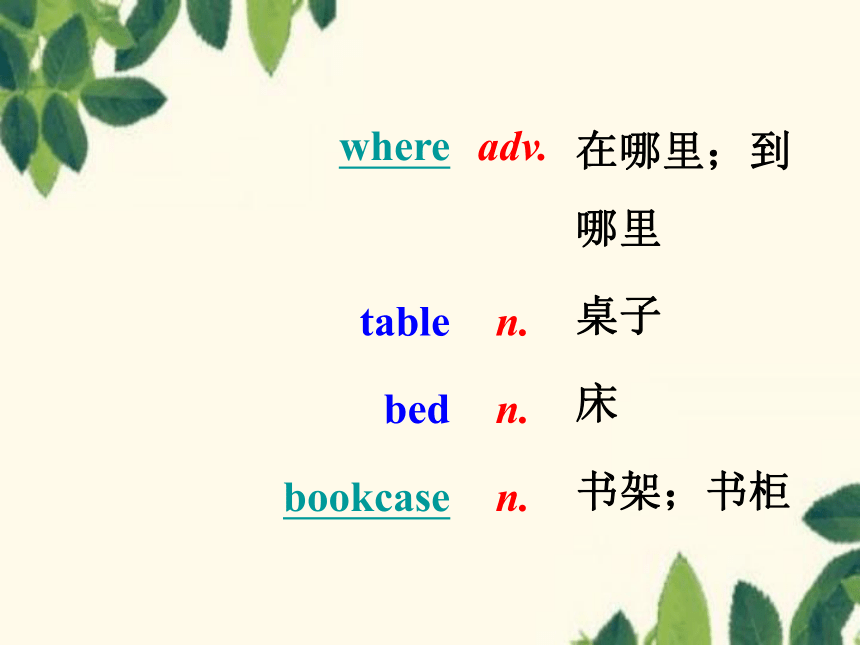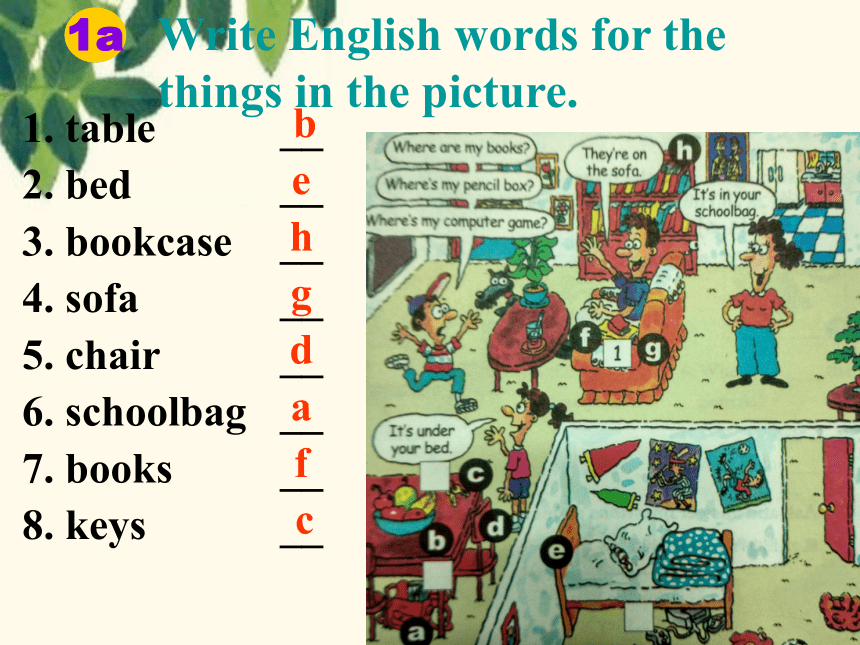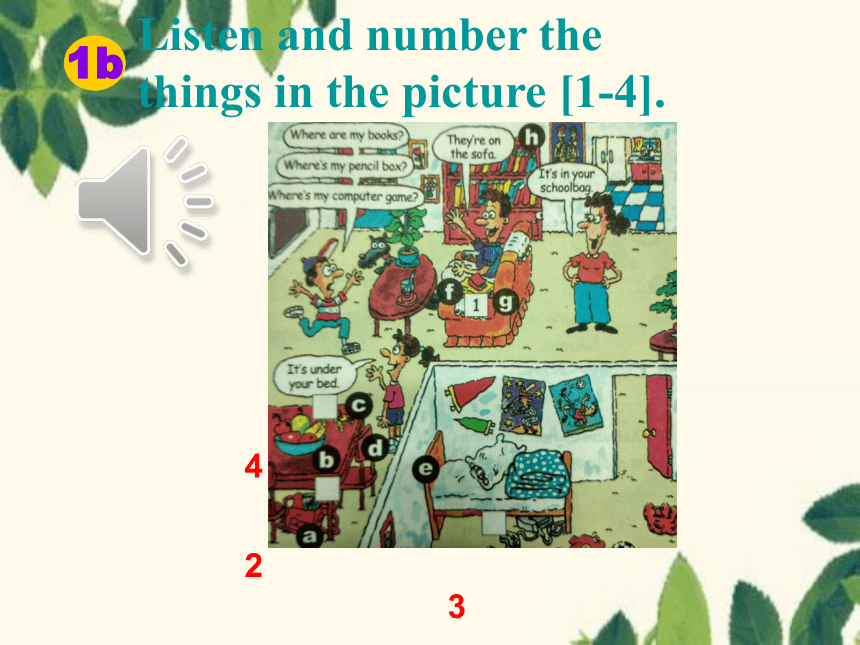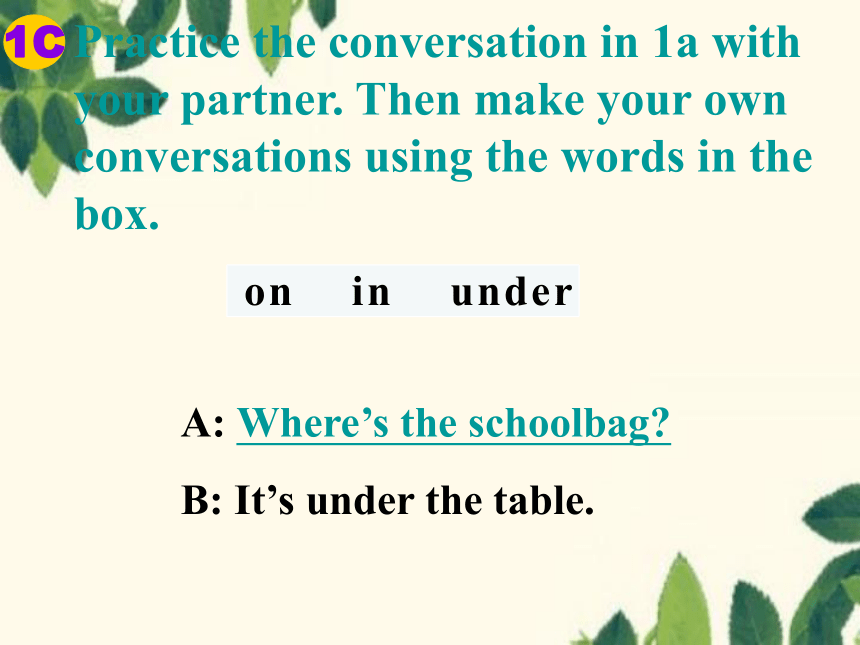Unit 4 Where's my schoolbag-Section A(1a – 2c)课件+嵌入音频(共18张PPT)
文档属性
| 名称 | Unit 4 Where's my schoolbag-Section A(1a – 2c)课件+嵌入音频(共18张PPT) |  | |
| 格式 | ppt | ||
| 文件大小 | 14.9MB | ||
| 资源类型 | 教案 | ||
| 版本资源 | 人教新目标(Go for it)版 | ||
| 科目 | 英语 | ||
| 更新时间 | 2022-09-13 09:42:06 | ||
图片预览







文档简介
(共18张PPT)
Unit 4
Where’s my schoolbag
Section A
(1a – 2c)
where
table
bed
bookcase
adv.
n.
n.
n.
在哪里;到哪里
桌子
床
书架;书柜
sofa
chair
on
under
n.
n.
prep.
prep.
沙发
椅子
在……上
在……下
Write English words for the things in the picture.
1a
1. table __
2. bed __
3. bookcase __
4. sofa __
5. chair __
6. schoolbag __
7. books __
8. keys __
b
e
h
g
d
a
f
c
Listen and number the things in the picture [1-4].
1b
2
3
4
Practice the conversation in 1a with your partner. Then make your own conversations using the words in the box.
1C
on in under
A: Where’s the schoolbag
B: It’s under the table.
Listen and number the things [1-6].
2a
2
3
4
5
6
1
Listen again. Find the things from 2a and number them in the picture[1-6]
2b
2
3
4
5
6
Ask and answer questions about the things in the picture in 2b.
2c
A: Are the keys on the sofa
B: No, they aren’t. They’re on the table.
End
1. where adv.在哪里;到哪里
用于疑问句,询问“某人或某物在哪里”。
3. bookcase n.书架;书柜
同义词:bookshelf
BACK
5. on prep.在……上
表示上面的物体与下面的物体至少有一个接触点。
6. under prep.在……下
指的是在某个物体的垂直正下方。
BACK
— Where’s the schoolbag 书包在哪里?
— It’s under the table. 在饭桌下。
(1) where是一个特殊疑问词,用来引导一个询问地点的特殊疑问句,其后要接一个一般疑问句。
Where is my pen 我的钢笔在哪?
Where are my rulers 我的尺子在哪呢?
where后面的be动词使用is还是are,取决于后面的名词单复数或代词的形式;即单数名词作主语,be动词用is;复数名词作主语,则用are。
(2) 对于where疑问句的回答,常使用表示地点的介词短语。
Your pen is in the pencil box. 你的钢笔在文具盒里。
Your rulers are on the desk.你的尺子在书桌上。
因为询问的物体往往是说话人和听话人都知道的人或物,所以使用名词时,往往要在前面加上形容词性的物主代词或定冠词;其回答时使用的介词短语的结构也是:介词+the / 物主代词+名词(往往是单数形式)。
— Where is the dictionary 字典在哪儿呢?
— It’s in your schoolbag. 在你书包里。
在“主语+be动词+介词短语”的句型中,be动词往往是不译成汉语的。
BACK
Unit 4
Where’s my schoolbag
Section A
(1a – 2c)
where
table
bed
bookcase
adv.
n.
n.
n.
在哪里;到哪里
桌子
床
书架;书柜
sofa
chair
on
under
n.
n.
prep.
prep.
沙发
椅子
在……上
在……下
Write English words for the things in the picture.
1a
1. table __
2. bed __
3. bookcase __
4. sofa __
5. chair __
6. schoolbag __
7. books __
8. keys __
b
e
h
g
d
a
f
c
Listen and number the things in the picture [1-4].
1b
2
3
4
Practice the conversation in 1a with your partner. Then make your own conversations using the words in the box.
1C
on in under
A: Where’s the schoolbag
B: It’s under the table.
Listen and number the things [1-6].
2a
2
3
4
5
6
1
Listen again. Find the things from 2a and number them in the picture[1-6]
2b
2
3
4
5
6
Ask and answer questions about the things in the picture in 2b.
2c
A: Are the keys on the sofa
B: No, they aren’t. They’re on the table.
End
1. where adv.在哪里;到哪里
用于疑问句,询问“某人或某物在哪里”。
3. bookcase n.书架;书柜
同义词:bookshelf
BACK
5. on prep.在……上
表示上面的物体与下面的物体至少有一个接触点。
6. under prep.在……下
指的是在某个物体的垂直正下方。
BACK
— Where’s the schoolbag 书包在哪里?
— It’s under the table. 在饭桌下。
(1) where是一个特殊疑问词,用来引导一个询问地点的特殊疑问句,其后要接一个一般疑问句。
Where is my pen 我的钢笔在哪?
Where are my rulers 我的尺子在哪呢?
where后面的be动词使用is还是are,取决于后面的名词单复数或代词的形式;即单数名词作主语,be动词用is;复数名词作主语,则用are。
(2) 对于where疑问句的回答,常使用表示地点的介词短语。
Your pen is in the pencil box. 你的钢笔在文具盒里。
Your rulers are on the desk.你的尺子在书桌上。
因为询问的物体往往是说话人和听话人都知道的人或物,所以使用名词时,往往要在前面加上形容词性的物主代词或定冠词;其回答时使用的介词短语的结构也是:介词+the / 物主代词+名词(往往是单数形式)。
— Where is the dictionary 字典在哪儿呢?
— It’s in your schoolbag. 在你书包里。
在“主语+be动词+介词短语”的句型中,be动词往往是不译成汉语的。
BACK
同课章节目录
- starters 预备篇(2012秋审查)
- Unit 1 Good morning !
- Unit 2 What’s this in English?
- Unit 3 What color is it ?
- Unit 1 My name's Gina.
- Section A
- Section B
- Unit 2 This is my sister.
- Section A
- Section B
- Unit 3 Is this your pencil?
- Section A
- Section B
- Unit 4 Where's my schoolbag?
- Section A
- Section B
- Unit 5 Do you have a soccer ball?
- Section A
- Section B
- Unit 6 Do you like bananas?
- Section A
- Section B
- Unit 7 How much are these socks?
- Section A
- Section B
- Unit 8 When is your birthday?
- Section A
- Section B
- Unit 9 My favorite subject is science.
- Section A
- Section B
